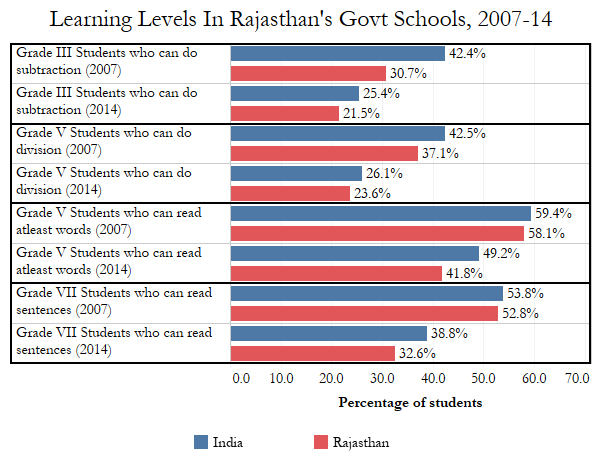Rajasthan–a state that has India’s fourth-lowest literacy rate–has signed understandings with the Tata Trusts (an Indian trust) and Khan Academy (a global nonprofit) to improve learning levels of students in government schools.

The interventions are aimed at addressing the education crisis in Rajasthan, which recorded an overall literacy rate of 67%–less than Cameroon, Egypt and Ghana–and the country’s lowest female literacy rate (52.66%), according to Census 2011. Rajasthan’s female literacy rate is worse than the average for the Arab world and “fragile and conflict-affected” countries, according to World Bank data.
India’s seventh most populated state (68.5 million people), with 24% of its population between the ages of six and 14, Rajasthan also has many children out of school (5%), according to government data.

As the first part of this series observed, literacy rates and learning outcomes are some of the lowest in the BIMARU (Bihar, Madhya Pradesh, Rajasthan and Uttar Pradesh) states. By 2020, India will have the world’s largest working-age population–869 million–but an IndiaSpend analysis of these four states–with 43.6% of India’s school-age population between the age of five and 14–revealed that India is unprepared to educate and train its young population.
Rajasthan’s overall literacy rate improved 6.6 percentage points over 10 years to 2011, data show, against an all-India improvement of 9.2 percentage points to 74.04% from 64.8%. But these improvements hide some of India’s sharpest declines in learning levels, particularly in rural government schools.
As learning levels decline, so does government school enrolment
Even though the state’s pupil teacher ratio at the primary level, from grade I to V (17), upper primary level, from grade V to VIII (10), and the classroom teacher ratio (21) at the elementary school level (grade I to VIII) is better than the Indian average, learning outcomes have not improved.
Reading and arithmetic levels of students between standards II and V have declined across government and private schools in rural Rajasthan, according to the Annual Status of Education Report (ASER) 2014.
In government schools, the percentage of children in grade II “who can read at least letters” reduced from 80.5% in 2010 to 56.2% in 2014. In private schools, the percentage reduced from 93.8% in 2010 to 81.5% in 2014.
The percentage of children in Rajasthan in grade V, who can “read at least words” declined from 51% in 2007 to 27% in 2014 in government schools, while reading levels in private schools declined from 78% to 64% over the same period, according to ASER data.

Source: ASER Trends over Time Report (2006-14)
Rural government schools have witnessed a continuous decline in enrolment, matched partly by an increase in private school enrolment. As many as 42% of children between six and 14 years were enrolled in private schools in 2014, against 25% in 2006; enrolment in government schools declined from 63.6% in 2006 to 52.2% in 2014, according to the ASER – Trends Over Time Report.
The average attendance in grade I in public and private schools was 65.9% based on classroom attendance registers seen by ASER volunteers, according to an ASER study from 2010. Regular teacher attendance was 72.55%, calculated based on the two days the ASER team visited schools.
A drop in learning levels could indicate that little has changed between 2010 and 2014, when ASER conducted its most recent survey. (The ASER 2016 survey results are set to be released on January 18, 2016.)
At the same time, well-designed interventions can boost learning, with an innovative teaching system in six Rajasthan districts recording average score increases–irrespective of gender and social background–of 45% in Hindi, 26% in English and 44% in math, as IndiaSpend reported in October 2016.
India’s highest proportion of women without schooling , many out-of-school children
In 2013-14, at the elementary level, there were 5% out-of-school children in Rajasthan, according to the 2015 Digital Gender Atlas for Advancing Girls’ Education: 18% of those were children who have never been to school, while 37% were dropouts. More girls (7%) than boys (3%) were out of school.
Parents’ education impacts school education, according to this 2001 paper published in the Review of Development Economics, with higher parental education improving school enrolment. Rajasthan recorded the highest percentage of mothers across Indian states (69.7%) with no schooling, according to ASER 2014.
Besides parents’ education, another factor that could affect attendance and retention at government schools is a well-functioning mid-day meal programme. Continued exposure to mid-day meals contributed to an increase in test scores, according to this 2016 study. Reading scores improved by 18% for children exposed for five years to mid-day meals, in comparison to children who had been exposed to mid-day meals for less than a year. The arithmetic test scores witnessed an improvement of 9%.
The proportion of government schools serving midday meals in Rajasthan on the day of visit of the ASER team in 2014 declined from 94.8% in 2010 to 82.7% in 2014, despite the availability of infrastructure (such as a kitchen) increasing from 83.8% in 2010 to 89.8% in 2014, according to the ASER 2014 report.
Schools are also less accessible for students in Rajasthan. In 2013-14, Rajasthan was ranked 31 among 35 states and union territories for elementary schools accessible by all-weather roads, according to data published by the Digital Gender Atlas. Only 76.5% of elementary schools were accessible by all-weather roads, compared to the all-India average of 89%, the data show.
Of six million teaching positions in government schools nationwide, about 900,000 elementary school teaching positions and 100,000 in secondary school—put together, a million—are vacant, as IndiaSpend reported in December 2016, according to an answer given in the Lok Sabha (lower house of Parliament). About 13.2% of all elementary teaching positions–nearly 37,500–in government schools in Rajasthan are vacant.
Series concluded. You can read the first part here, the second part here, the third part here and the fourth part here.
(Balani is a freelance writer based in Mumbai, with an interest in development issues.)
Courtesy: India Spend